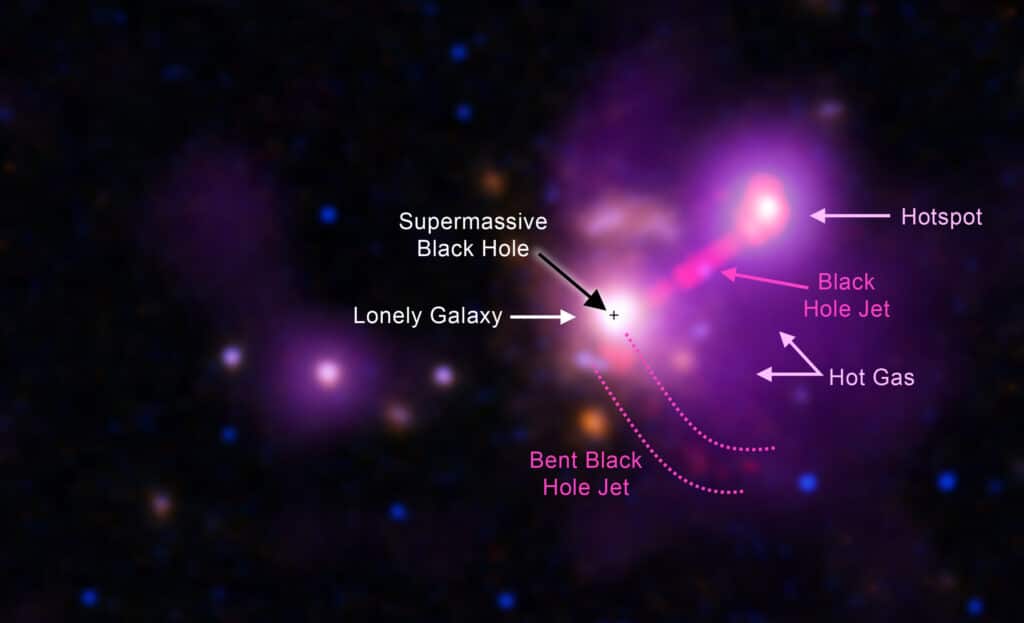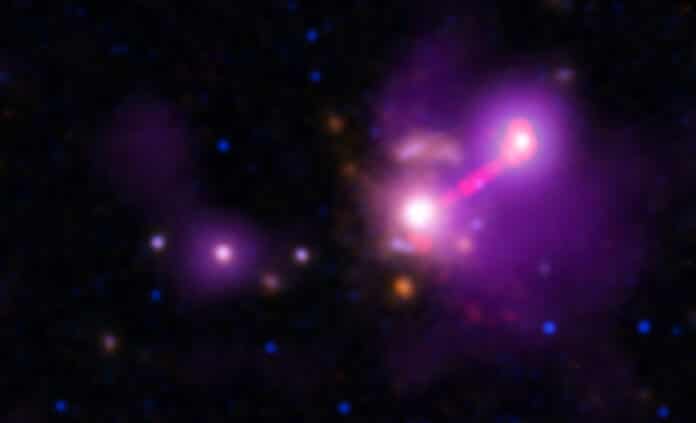Using NASA’s Chandra X-ray Observatory and the International Gemini Observatory, astronomers identified a distant and lonely galaxy located about 9.2 billion light-years from Earth. This surprisingly lonely galaxy has pulled in and assimilated all of its former companion galaxies.
The galaxy, known as 3C 297, contains a quasar, a supermassive black hole pulling in gas at the galaxy’s center and driving powerful jets of matter seen in radio waves. It has features of a galaxy cluster, enormous structures that usually contain hundreds or even thousands of galaxies. Yet 3C 297 stands alone.
Valentina Missaglia of the University of Torino in Italy, who led the study, said, “It seems that we have a galaxy cluster that is missing almost all of its galaxies. We expected to see at least a dozen galaxies about the size of the Milky Way, yet we see only one.”
Missaglia and her colleagues see two critical traits of a galaxy cluster in the Chandra X-ray data:
A significant amount of gas surrounds the lone galaxy with temperatures of tens of millions of degrees, which is often seen in galaxy clusters, according to the X-ray data.
Second, the powerful X-ray emission that the supermassive black hole’s jet has produced at a distance of 140,000 light-years suggests that the jet has smashed into gas encircling the galaxy.

A third characteristic of galaxy clusters that 3C 297 exhibits is one of the radio jets is twisted, indicating that it has interacted with its surroundings. This characteristic was previously discovered in Karl G. Jansky Very Large Array data.
Missaglia’s team’s data from the Gemini Observatory in Hawaii showed that none of the 19 galaxies that appear nearby to 3C 297 in a Gemini optical image and that have precise distance measurements are actually at the same distance as the lonely galaxy, despite having these crucial characteristics of a galaxy cluster.
Co-author Juan Madrid of the University of Texas, Rio Grande Valley, said, “What happened to all of these galaxies? We think the gravitational pull of the one large galaxy combined with interactions between the galaxies was too strong, and they merged with the large galaxy. For these galaxies, apparently, resistance was futile.”
According to astronomers, 3C 297 is now a “fossil group” rather than a galactic cluster. A galaxy is pushing in and merging with several other galaxies at this point in the process. Although other fossil groups have already been found, this one is unusually far out at 9.2 billion light-years.
Co-author Mischa Schirmer of the Max Planck Institute for Astronomy said, “It may be challenging to explain how the universe can create this system only 4.6 billion years after the big bang. This doesn’t break our ideas of cosmology, but it begins to push the limits on how quickly both galaxies and galaxy clusters must have formed.”
Although the authors cannot completely rule out the possibility of dwarf galaxies in 3C 297, their existence still wouldn’t account for the absence of larger galaxies like the Milky Way. Examples close by include M87 in the Virgo Cluster, which has huge galactic neighbors and has existed for billions of years. Nonetheless, 3C 297 will effectively be alone for billions of years.
Journal Reference:
- Valentina Missaglia, Juan Madrid et al. Powerful Yet Lonely: Is 3C 297 a High-redshift Fossil Group? The Astrophysical Journal. DOI 10.3847/1538-4365/ac9f3e
